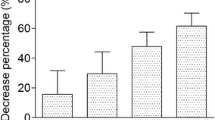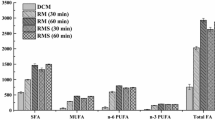Abstract
The study of the stability of saturated mono-, or polyunsaturated fatty acids, both esterified and not esterified, in plasma, circulating cells, and tissues is extremely important to validate the use of biological samples stored at low temperature in “biological banks”, which are used for experimental, observational, dietary, or pharmacological studies. Since red blood cells are easily accessible cells, they are used as a marker of less-accessible tissues, especially in large-scale epidemiological studies. Data from the literature suggest that the addition of an antioxidant and the freezing of red blood cells do not cause any variation in the fatty acid composition for a period of 2–6 months up to 1 year. We evaluated the fatty acid concentration in red blood cells isolated from venous blood samples of one subject, preserved with butylated hydroxytoluene and N2 and stored at −80°C for up to 2 years. Erythrocytes of venous samples of six subjects stored at −20°C for 6 months without butylated hydroxytoluene and in the presence of air were used for comparison purposes. Our data demonstrate that a long storage time (2 years) does not significantly influence the erythrocyte fatty acid concentration when using very low temperatures (−80°C) and antioxidants (butylated hydroxytoluene) in the presence of N2.
Similar content being viewed by others
References
Ways PO. Degradation of glycerophosphatides during storage of saline-washed, saline-suspended red cells at −20°C. J Lipid Res 1967; 8:518.
Broekhuyse RM. Long-term storage of erythrocytes for quantitative analyses of lipids. Clin Chim Acta 1974; 52:53.
Otto SJ, Foreman-v.Drougelen MMHP, Houwelingen AC v, Hornstra G. Effects of storage on venous and capillary blood samples: the influence of deferoxamine and butylated hydroxytoluene on the fatty acid alterations in red blood cell phospholipids. Eur J Clin Chem Clin Biochem 1997; 35:907.
Dodge JT, Mitchell C, Hanahan DJ. The preparation and chemical characteristics of hemoglobin-free ghosts of human erythrocytes. Arch Biochem Biophys 1963; 100:119.
Dodge JT, Phillips GB. Autoxidation as a cause of altered lipid distribution in extracts from human red cells. J Lipid Res 1966; 7:387.
Glatz JFC, Soffers AEMF, Katan MB. Fatty acid composition of serum cholesteryl esters and erythrocyte membranes as indicators of linoleic acid intake in man. Am J Clin Nutr 1989; 49:269.
Romon M, Nuttens MC, Théret N, Delbart C, Lecerf JM, Fruchart J-C, Salomez J-L. Comparison between fat intake assessed by a 3-day food record and phospholipid fatty acid composition of red blood cells: results from the monitoring of cardiovascular disease — Lille Study. Metabolism 1995; 44:1139.
Farquhar JW, Ahrens EH. Effects of dietary fats on human erythrocyte fatty acid patterns. J Clin Invest 1963; 42:675.
Dougherty RM, Galli C, Ferro-Luzzi A, Iacono JM. Lipid and phospholipid fatty acid composition of plasma, red blood cells, and platelets and how they are affected by dietary lipids: a study of normal subjects from Italy, Finland and the USA. Am J Clin Nutr 1987; 4:443.
Hill JG, Kuksis A, Bevreridge JMF. The effect of diet on the phospholipid composition of the red blood cells in man. J Am Oil Chem Soc 1965; 42:137.
Stanford JL, King I, Kristal AR. Long-term storage of red blood cells and correlations between red cell and dietary fatty acids: results from a pilot study. Nutr Cancer 1991; 16:183.
Folch J, Lees M, Stanley HS. A simple method for the isolation and purification of total lipids from animal tissues. J Biol Chem 1957; 226:497.
Sheppard AJ, Iverson JL. Esterification of fatty acids for gas-liquid chromatographic analysis. J Chromatogr Sci 1975; 13:448.
Snedecor GV, Cochran WG. Statistical methods, 7th edn. Ames: Iowa State University Press, 1980: 91–116 and 172–198.
Wallenstein S, Zucker L, Fleiss JL. Some statistical methods useful in circulation research. Circ Res 1980; 477:1.
Author information
Authors and Affiliations
Rights and permissions
About this article
Cite this article
Di Marino, L., Maffettone, A., Cipriano, P. et al. Assay of erythrocyte membrane fatty acids. Effects of storage time at low temperature. Int J Clin Lab Res 30, 197–202 (2000). https://doi.org/10.1007/BF02874182
Received:
Accepted:
Issue Date:
DOI: https://doi.org/10.1007/BF02874182




